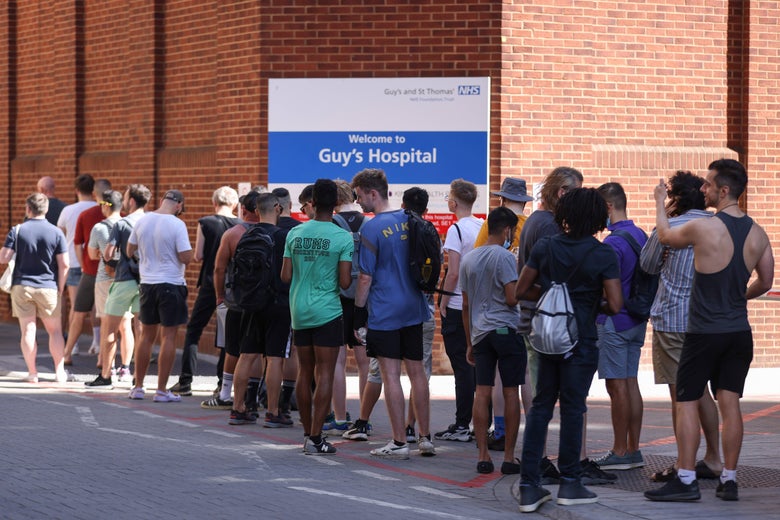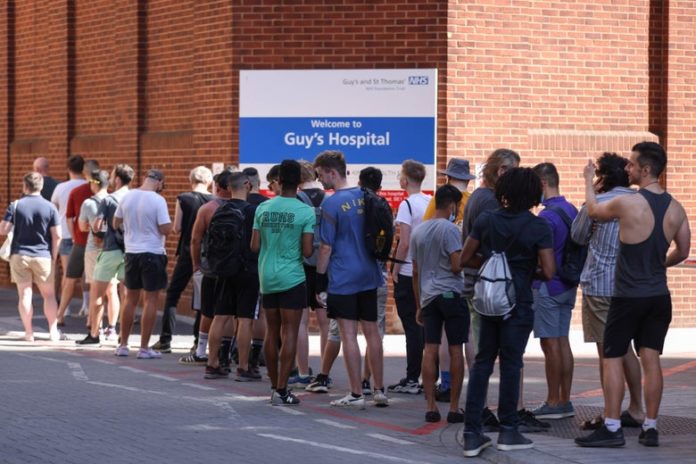
Lisa, a 30-year-old mom living in Chicago, has seen the warnings.
Monkeypox spreads through contaminated clothes, the virus lives on surfaces for months, and it might even be airborne. Monkeypox “will become established in the pediatric and general population and will transmit through daycares and schools,” a prominent doctor on Twitter declares.
Is it risky, Lisa wonders, to shop at the grocery store? Can she keep her child, born during the first year of the COVID pandemic, safe? Will she have to go back to living like she did in 2020?
Advertisement
“I had finally gotten to the point with COVID where I was starting to relax,” she said (Lisa requested to go by her first name only). “But when I heard about monkeypox, it was like a huge pit in my stomach. I open Twitter and see people telling me you need a full PPE suit to go outside. I can’t take living in fear for another two years, and I want to let my child live a normal life.” She’s trying to be rational about the newly-spreading virus, but it’s difficult. “I worry about monkeypox, then I don’t, then I do again, because the messaging has been pretty inconsistent,” she explains.
Advertisement
Advertisement
Advertisement
The message that anyone can get monkeypox, widely disseminated by public health officials and the media, is not incorrect, but it is misleading. The Centers for Disease Control and Prevention lists direct contact with monkeypox sores, respiratory secretions during face-to-face contact, sex, cuddling, and touching contaminated items as potential transmission routes—but they’re not all equally risky. The raging social media debate about whether monkeypox can be considered a sexually transmitted infection misses the point: Right now, it is primarily spreading during sex and, like most STIs, it can be transmitted other ways as well.
Advertisement
Advertisement
While anyone could potentially catch the virus through close physical contact, the “vast majority” of people getting it now are gay and bisexual men, according to CDC director Dr. Rochelle Walensky. In a recent study of more than 500 cases in 16 countries, 98 percent were among men who have sex with men, and sexual contact was identified as the likely transmission route in 95 percent of cases.
So far, there have been a relatively small number of cases outside of this group: health officials have reported around 100 monkeypox cases among women worldwide—about 1 percent of the global total. Last week the CDC announced the first two cases in children in the United States, both attributed to household contact. A slow start to testing efforts left some experts worried that monkeypox could be spreading undetected among women and kids. But as testing capacity has expanded and more women have gotten tested, few are turning up positive—just eight out of 2,891 cases in the United States, according to the CDC’s latest tally.
Advertisement
Advertisement
The mixed messaging has left the public understandably confused. Women have gone viral on social media describing their frustration at being unable to get tested when they developed telltale sores, but many more common conditions, including herpes, staph infection, and acne can look like monkeypox. (Slate attempted to speak with women who tested positive but was unable to find any.)
Advertisement
Advertisement
“The last thing I wanted to see was another disease outbreak just as things were starting to feel a bit more normal,” says Zie Gosset, 25, of Chattanooga, Tennessee, who has been watching all of this play out on her phone screen. “When monkeypox came around in mid-May, it brought up a lot of unresolved trauma and anxiety from the early months of 2020. Would I be at risk? Would I end up at home for nearly a month with a painful rash?” It didn’t help her anxiety to see social media pundits with hundreds of thousands of followers “state with certainly that monkeypox was going to rip through schools and businesses and rapidly infect everyone.”
Advertisement
Advertisement
COVID taught us the perils of making predictions about a new epidemic, but many experts do not foresee an explosion of cases outside gay men’s sexual networks. The European Center for Disease Prevention and Control, for example, considers the likelihood of monkeypox spreading further among networks of people with multiple sex partners to be high, but the chances of it spreading among the broader population to be “very low.”
Advertisement
Advertisement
“We are likely to see more limited types of spread in other groups in newly affected countries with occasional cases in household contacts of infected persons or even transmission from animals,” Dr. Boghuma K. Titanji, an assistant professor of medicine at Emory University, told Slate. “But it’s hard to imagine that this will take off in other groups leading to large-scale outbreaks like what we are seeing in men who have sex with men.”
Advertisement
This is consistent with our understanding of monkeypox prior to the current outbreak. Historically, the disease has not been considered easy to transmit from person to person. Extensive outbreaks have never been reported in Central and West Africa, where the virus is endemic. During a 2003 outbreak in the Midwest, nearly 50 people caught monkeypox from pet prairie dogs, yet there were no known cases of human-to-human transmission.
Advertisement
While the virus itself does not appear to have become more transmissible, gay men’s sexual networks provided a favorable niche for explosive spread. While there’s always an element of chance with infectious diseases, monkeypox didn’t just happen to break out in this setting, and sex appears to be driving transmission. Monkeypox could potentially spread in settings where heterosexuals have a lot of sex—like college campuses—but the number and overlap of sex partners (what researchers call “concurrency”) makes a big difference in risk level.
Advertisement
Advertisement
“I feel that we can learn important lessons from HIV and sexually transmitted infections that most people either don’t know about or don’t want to talk about,” said Dr. Muge Cevik, a clinical lecturer in infectious diseases and medical virology at the University of St. Andrews in Scotland. “It’s the combination of networks and contact patterns, exposure routes and biology, that results in monkeypox disproportionately affecting men who have sex with men. Even if we see cases in [other] groups, there will not be as much risk for onward transmission and a broader epidemic.”
Some experts think a more pressing concern than a general population outbreak is the prospect that monkeypox could become a permanent menace for gay and bisexual men.
Advertisement
“Based on what we know now, it’s very likely that monkeypox will become entrenched in the United Stated as a sexually transmitted infection. This virus reinforces why sexual health services are critical,” said Dr. Jay Varma, a professor of population health sciences at Weill Cornell Medical College.
Still, what’s the harm in applying the “precautionary principle”? One effect is stoking unnecessary fear, which could lead to negative social and political consequences such as school closures. And suggesting that people can catch monkeypox via casual contact could make them afraid to be around gay men, as we saw during the early years of the AIDS epidemic.
Advertisement
Advertisement
Advertisement
Advertisement
“Health officials don’t want to perpetuate stigma, which I completely agree with,” said Lisa. “But I can imagine that there are people out there who don’t want to be within ten feet of a gay person now. If you follow the wrong people, you could come to that conclusion.”
Advertisement
In reality, Lisa should avoid close skin-to-skin contact with people with monkeypox—sitting on the same subway seat or brushing past someone on the sidewalk aren’t risky. She should also be cautious about prolonged close contact with someone who is positive, such as living in the same household or being a caregiver. Gay men and others at high risk can keep themselves safe by getting vaccinated, but experts don’t recommend it for the population at large.
Experts do want everyone to be aware of how monkeypox is transmitted and want providers to know what symptoms to look for. The sores can be excruciatingly painful, but the risk of death is very low (none so far in the current outbreak). Monkeypox is nothing to take lightly, but for most people, it doesn’t have to upend their lives.
Advertisement
“As researchers and clinicians, we should provide scientifically accurate information to the public so that they can make informed decisions,” Cevik told Slate. “I don’t think giving false or misleading information is harmless—in fact, it’s unethical.”
In addition to allaying the unwarranted fears of people like Lisa and Zie, an accurate understanding of relative risk is necessary for controlling the outbreak. Directing limited resources like testing and vaccines to the people who need them most—in this case gay and bisexual men—is the best way to prevent needless suffering. It’s also the best way to contain the outbreak and protect everyone else too.








